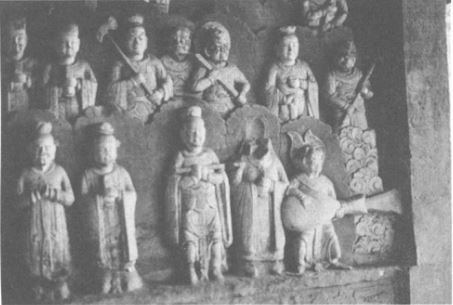 | ||
The hand cannon or gonne (also spelled handgonne to distinguish the device from modern handguns) (Chinese: 手銃; Arabic: مدفع; Russian: пищаль) is the first firearm and the successor of the fire lance. It is the oldest type of small arms as well as the most mechanically simplistic form of firearm. Unlike matchlock firearms it requires direct manual external ignition through a touch hole without any form of firing mechanism. It may also be considered a forerunner of the handgun. The hand cannon was widely used in China from the 13th century onward and later throughout Europe in the 14th century until at least the 1520s, when it was supplanted by the matchlock arquebus, which is the first firearm to have a trigger.
Contents
In modern usage, the term hand cannon may also be used colloquially to refer to a pistol or revolver chambered for a powerful cartridge, such as the .454 Casull or .500 S&W Magnum. This term is also sometimes used to refer to a novelty toy gun known as "pocket artillery", a small cannon firing steel balls by means of a smokeless powder or a firecracker.
Origins
The general consensus is that hand cannons first saw widespread use in China sometime during the 13th century and were spread from there to the rest of the world. However the earliest artistic depiction of a hand cannon is a hand cannon wielding rock sculpture found among the Dazu Rock Carvings dated to 1128. The oldest confirmed extant hand cannon is the Xanadu Gun, dated to 1298, but the Heilongjiang hand cannon is likely older and is dated to no later than 1288, however it contains no inscription or date era unlike the Xanadu Gun. Other specimens are also likely older and have been dated to the Western Xia period, but these too contain no inscriptions or era dates. The Heilongjiang hand cannon weighs 7.8 pounds, and could be carried by a soldier. The earliest reliable evidence of hand cannons in Europe comes from the 14th century, during which time both Europeans and Arabs appear to have begun using them. In East Asia, the Koreans acquired knowledge of the hand cannon from China in the 14th century. Japan was already aware of gunpowder warfare due to the Mongol invasions which saw the use of bombs, but did not produce firearms until 1543, when the Portuguese introduced matchlocks which were known as tanegashima to the Jpaanese.
Design and features
The hand cannon consists of a barrel, a handle, and sometimes a socket to insert a wooden stock. Extant examples show that some hand cannons also featured a metal extension as a handle.
The hand cannon could be held in two hands but another person is often shown aiding in igniting the cannon using moldering wood, coal, red-hot iron rods, and slow-burning matches. The hand cannon could be placed on a rest and held by one hand, while the gunner applied the means of ignition himself.
Projectiles used in hand cannons were known to include rocks, pebbles, and arrows. Eventually stone projectiles in the shape of balls became the preferred form of ammunition, and then they were replaced by iron balls from the late 14th to 15th centuries.
Later hand cannons have been shown to include a flash pan attached to the barrel and a touch hole drilled through the side wall instead of the top of the barrel. The flash pan had a leather cover and, later on, a hinged metal lid, to keep the priming powder dry until the moment of firing and to prevent premature firing. These features were carried over to subsequent firearms.
The invention of corned powder, the slow match, and the serpentine lever in mid-15th century Europe led to more powerful firearms. It also prompted the development of the first matchlock firearms, which could be more effectively aimed and fired than hand cannon.
Impact
The hand cannon was the first firearm used in the history of warfare, the first hand held fireweapon, and the predecessor of subsequent firearm weapons. Although it could not match up to the more powerful supergun or the utility of the arquebus, the power of cannon warfare was apparent as early as 1287 in Yuan dynasty China, when a contingent of hand cannon troops were deployed to put down a rebellion by the Mongol prince Nayan. In Europe depictions of hand cannons appeared as early as 1326 and evidence of their production appeared in 1327. The first recorded use of gunpowder weapons in Europe was in 1331 when two mounted Germanic knights attacked Cividale del Friuli with gunpowder weapons of some sort. By 1338 hand cannons were in widespread use in France.
Improvements in hand cannon and gunpowder technology – corned powder, shot ammunition, and development of the flash pan – led to the invention of the arquebus in 16th century Europe.
